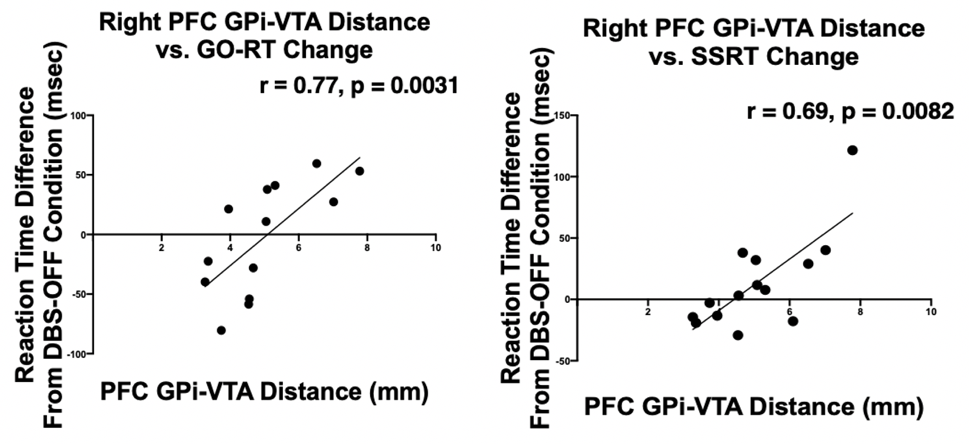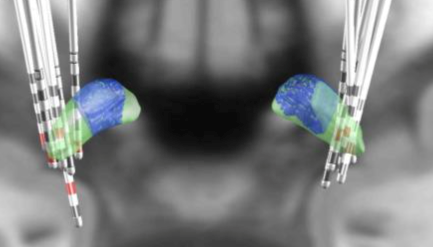Category: Surgical Therapy: Parkinson's Disease
Objective: To evaluate whether selective deep brain stimulation (DBS) stimulation of anterior region of globus pallidus internus (GPi) affects impulsivity in Parkinson’s Disease patients
Background: When postoperative medication reduction is not possible, many Parkinson’s Disease (PD) patients may experience impulsivity following STN-DBS[1-3]. The effect of GPi-DBS on impulsivity in PD is not well-described, though anterior GPi DBS has been effective for Tourette’s Syndrome, a disorder that involves impulsive control [4]. Since neuroanatomical substrates for inhibition are localized in the prefrontal cortex, to which a subregion of anterior GPi sends projections (PFC-GPi), we investigated the selective effect of stimulation of PFC-GPi on modulating motor impulsivity.
Method: Seven participants with PD with bilateral GPi DBS were recruited [Figure 1]. Stimulation volume of tissue activation (VTA) was modeled with Lead-DBS and varied relative to the PFC-GPi. The stimulation effect of DBS onto the (1) PFC-GPi was defined as a minimum distance between the surface of the PFC-GPi and the centroid of the VTA, and (2) entire GPi and other GPi subregions was defined as the VTA volumetric overlap. The severity of motor impulsivity was defined as the Stop Signal Reaction Time (SSRT), and the reaction speed as Go-Reaction Time (GO-RT) in the Stop Signal Reaction Task. The difference of SSRT and GO-RT from the DBS-OFF conditions was correlated with the distance between the VTA surface and the PFC-GPi centroid.
Results: The distance between the right PFC GPi and the VTA was positively correlated with the GO-RT difference (r=0.77, p<0.005) and SSRT difference (r=0.69, p<0.05) from the DBS-off condition [Figure 2]. This suggests that with a higher stimulation effect onto the PFC-GPi, increased motor initiation speed was observed, as well as enhanced inhibition of prepotent motor response with reduced impulsivity. Furthermore, VTA overlap with the right PFC-GPi (r=-0.64, p<0.05) and Premotor GPi (r=0.62, p<0.05) correlated with SSRT, respectively. VTA overlap with the right motor GPi did not correlate with SSRT, suggesting that the measure of impulsivity was not confounded by bradykinesia improvement.
Conclusion: Stimulation of the right PFC-GPi subregion may reduce impulsivity among PD patients. This may have implications for treatment of impulse control disorder or addiction.
References: [1]. Ballanger B, van Eimeren T, Moro E, et al. Stimulation of the subthalamic nucleus and impulsivity: Release your horses. Ann Neurol. 2009;66(6):817-824. doi: https://doi.org/10.1002/ana.21795. [2]. Hälbig TD, Tse W, Frisina PG, et al. Subthalamic deep brain stimulation and impulse control in parkinson’s disease. Eur J Neurol. 2009;16(4):493-497. doi: 10.1111/j.1468-1331.2008.02509.x [doi]. [3]. Hagelweide K, Schönberger AR, Kracht LW, Gründler TOJ, Fink GR, Schubotz RI. Motor cognition in patients treated with subthalamic nucleus deep brain stimulation: Limits of compensatory overactivity in parkinson’s disease. Neuropsychologia. 2018;117:491-499. doi: S0028-3932(18)30307-5 [pii]. [4]. Frank MC, Piedad J, Rickards H, Cavanna AE. The role of impulse control disorders in tourette syndrome: An exploratory study. J Neurol Sci. 2011;310(1-2):276-278. doi: 10.1016/j.jns.2011.06.032 [doi].
To cite this abstract in AMA style:
M. Kim, S. Baybayan, K. Moussawi, K. Mills. Deep Brain Stimulation of Anterior Globus Pallidus internus Reduces Impulsivity in Parkinson’s Disease [abstract]. Mov Disord. 2021; 36 (suppl 1). https://www.mdsabstracts.org/abstract/deep-brain-stimulation-of-anterior-globus-pallidus-internus-reduces-impulsivity-in-parkinsons-disease/. Accessed December 28, 2025.« Back to MDS Virtual Congress 2021
MDS Abstracts - https://www.mdsabstracts.org/abstract/deep-brain-stimulation-of-anterior-globus-pallidus-internus-reduces-impulsivity-in-parkinsons-disease/


